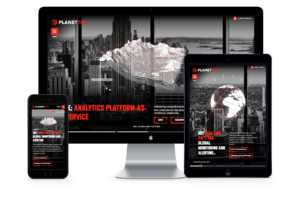A Google search of “cyber security companies” will return well over 700 million results. As a business becomes increasingly digital and transitions more operations into cloud-based tools, the data of both the business and its customers become increasingly vulnerable to cyber attacks. Cyber security companies are cropping up in response to growing demand across industries, but even the cyber security companies have to worry about protection, especially when it comes to their websites. As its digital storefront, any website is a critical place to ensure proper security measures are in place.
Here are the top five steps that cyber security companies themselves are taking to keep their websites protected.
1. Ensure CMS Security
The most cost-efficient way to build and manage a website is to leverage a popular content management system, but on their own these systems are often prone to attacks. To mitigate vulnerability, cyber security companies install a series of security plugins or modules, such as Securi for WordPress and Security Kit or Paranoia for Drupal.
Important Note: Simple installing the plugin or module is not sufficient. To protect your website and its data, webmasters must update and configure new releases in a timely manner. Website design and development agencies, such as Bluetext, can ensure your site security is always up to date.
When Bluetext partnered with ManTech to completely redesign their website, CMS security was a major concern. ManTech is a multi-billion-dollar public company that provides subcontracted technological services to the US Government. We outfitted their new Drupal website with the latest and greatest security plugins to ensure adequate CMS security.

2. Leverage Two-Factor Authentication
The content management system supporting a website needs to be easy-to-use, but not easy-to-access. Top cyber security companies (and the cyber security marketing firms who design and build their sites) ensure that only entrusted individuals can manage content on their sites by implementing two-factor authentication. When a content editor attempts to login in to update a page, they must validate their identity through a secondary step, such as a text message, phone call, or email. We often recommend Duo from Cisco, which integrates easily with most content management systems.
When CyberArk, a Goldman Sachs-backed, global cybersecurity technology company turned to Bluetext to redesign its brand comprehensively, we also launched a new responsive digital platform, complete with two-factor authentication. The new website addressed the needs of CyberArk’s global enterprise customer base.

3. Setup (BIG) Form Security
Web forms are valuable tools to digital marketers — and hackers! The potential for attacks initiated via a web form is BIG, hence they need big security. Cyber security companies, like many other industries, use web forms as a key lead-generation tool, but they know these forms are not something to be taken lightly. Any element on your site that allows for (and actively seeks) user input is susceptible to SQL injections or spam bots. (The tl;dr for those links: you do not want your website to suffer either fate.) The key IT stakeholder for any website should make form security a top priority, and work with the website development agency to select and implement the right technical measures.
When Finite State, an IoT-based cybersecurity company, came to Bluetext to expand its industry presence through a full website development and rebrand, we made sure that form security was paramount to the fully customized WordPress content management system platform.

4. Don’t Skimp on Hosting
While GoDaddy allows a company to save money, cyber security companies know that those savings come at an even higher cost in terms of security vulnerabilities. Though secure hosting providers come with a higher monthly bill, the long-term peace of mind in security far outweighs the short-term costs. These providers offer SSL certificates, CDNs, firewalls and more to ensure that websites can withstand malicious malware and attacks. Some of the top secure hosting providers recommended by top website development agencies include WP Engine and HostPapa.
Hosting security was top of mind for our client, PlanetRisk. When PlanetRisk, an enterprise risk analytics company, hired Bluetext to lead a comprehensive rebrand and new digital user experience and re-platform their content management system, we made sure that their updated website was fully secure, hosting-wise.

5. Take a Proactive Stance
Too often, website security measures are only implemented as a reactionary step following an attack. Cyber security companies know better. If a malicious attacker penetrates the website, they could irreversibly tarnish the brand. Cyber security companies make sure that the steps above are covered before an attack by configuring them before the website launches. Proactive protection can be a challenge if you don’t know what to expect, so be sure to consult an experienced website development agency to ensure your bases are covered with the most up to date security measures.
If you model your website security initiatives after the experts, you’ll be best set up to withstand attacks. Learn from the experience of a cyber security marketing agency—don’t skip these important steps!
There’s good news and bad news for companies hoping to make their mark in the cyber security universe. First the good news: The market for these products is huge and growing exponentially. Security Analyst and researcher Richard Stiennon, in a column on Forbes.com and extrapolating from Gartner data, projects a ten-fold increase in IT security spending over the next 10 years- to $639 billion annually by 2023. That’s a number that would have any company executive working overtime to tap into.
But here’s the bad news: This is not exactly a secret. The competition is fierce and growing, as the growing number of solution providers races to meet this demand and take advantage of the opportunity.
It’s easy to have a marketing plan that pushes key messages out to prospective customers. At Bluetext, we think an influencer strategy is essential as part of that plan, and especially in such a crowed space as cyber security.
How any company—from established household names to challenger brands—can break through the noise and the clutter to attract the attention of this market requires an engaging and creative marketing approach that clearly sets it apart and above the competition. This demands a fine understanding of the value it brings to its customers and why it’s the best solution for any particular challenge.
Yet, simply having great creative is only half the battle. Getting that message out to the market is a whole new challenge, and needs both a direct approach and an in-direct strategy—the bank shot to reach the intended audience. Direct tactics are obvious—direct mail, email blasts, online and print advertising, a digital presence, trade shows and webinars; these are all direct appeals to potential customers.
The indirect approach is in many ways more difficult. It requires using industry influencers to reach their larger audiences with your content and messages. That is no small task, and it takes a dedicated investment in time and research. Here are some of the required elements to implement an effective influencer strategy:
1. Identify the best influencers for cyber security.
2. Recruit those influencers as allies and advocates for your thought leadership.
3. Engage those influencers through social media and direct outreach so that they will spread the word to their audiences.
Let’s take these one at a time.
Identify. Identifying the right influencers for any market, and in particular for cyber security, takes some research and digging. The key is finding the leaders who not only have the most followers on social media, but whose content—including tweets, blog posts and news articles—are shared the most frequently. When Bluetext executes an influencer campaign for its clients, we look first at the number of twitter followers and LinkedIn connections for each influencer candidate. But that’s only our starting point. More important is researching their history of shares among that audience. If a particular individual has a large number of followers yet few who share and rebroadcast that content, it could mean that his followers don’t find his content to be valuable, or that he doesn’t post content very often. If there are a lot of shares, retweets and comments, that’s a good indication that the person is read and taken seriously across the industry.
Recruit. Recruiting an influencer doesn’t mean offering them a job. It means building a relationship so that that person knows you are reading his content and pushing it out to your audience. The best way to do this takes work. The first step is to follow that person on Twitter, and to subscribe to his feed if he has a syndication service. The second step requires that the person’s content be reviewed on a daily basis. Any time there is a post that is relevant to your market, share it, follow it, retweet it, comment on it or call it out and add your own perspective. The idea is demonstrate that you are an active fan and follower who is paying attention to the expert.
Engage. Engaging with the influencer is a long-term project. After you have shown interest and built a credible track record of reading and sharing his content, he can be approached as an industry expert, a colleague and a reporter. That might include asking for his opinion on a new development, offering to share an announcement that he might find interesting, and even giving an advance look at a new piece of research or development. The goal is to be viewed the same way that a reporter would view a valuable source—with credibility and interest. When that engagement is solidified, the influencer is much more likely to pay attention to your content and to share it with his audience.
This may seem like a cumbersome process, and Bluetext dedicates a fair amount of energy to make this happen for our clients. But the payoff is significant. Using the bank shot to reach a much broader audience through sources that they trust can help rise above the competition in a crowded and growing market. A smart influencer strategy takes time and commitment, but it’s worth the effort.
RSA Conference 2015 attendees convening on San Francisco April 20-24th in search of scantily clad woman fronting vendor booths will be sorely disappointed, as RSA became the latest group to ban “booth babes.”
There are many factors at work in the push away from booth babes, with the most substantive being that they are undeniably demeaning. In evaluating this conference shift, I can’t help think of the recent Hooters TV ad with Jon Gruden, which infers that “Hooters Girls make your wings taste better and your beer colder.” I’m not sure that can be scientifically proven, but if it could then the chain is really onto something. Along those lines, my guess is that conferences and technology vendors would likely give greater pause to moving away from booth babes if the women in fact made their technology produces look cooler and work better.
But there is scant evidence that booth babes generate more leads and sales. In one such proof point, Spencer Chen, head of marketing and growth at Frontback, penned a guest post for TechCrunch that drew attention to their own split-testing (two different booths at a show, one with booth babes, one staffed with subject matter experts) at a major industry conference. The result: the booth babes generated a third of the foot traffic and less than half the leads.
Isolated results? Perhaps, but probably not. The attendees who are drawn to booth babes are probably the same ones who are more interested in stuffing their swag bag than they are evaluating vendor offerings. For me personally, I find vendor employees far more approachable and less intimidating than women in bikinis, but I wasn’t exactly High School prom king so maybe that’s just me. Either way, given how this booth tactic portrays women and lack of evidence the strategy even works, booth babes smack of an outdated relic that can undermine customer perception of the brand.
For vendors that have used booth babes and now must look at alternative approaches, it is a gut check to solidify common sense strategies such as staffing the booth with seasoned employees who can address prospect inquiries at a business and technical level; ensuring prospects and customers are alerted pre-show and are compelled to stop by your booth; aligning the show marketing team with public relations and social media efforts, etc.
I’ve attended several major technology conference shows with clients over the past year, and beyond the tried-and-true tactics referenced above, some of the more effective booth “pull” strategies I have seen include:
- Booths that adapt to time of day – Attending a recent conference, one vendor had a gourmet coffee station set up during the morning and early afternoon hours of the show, and then switched to a beer tap towards later afternoon. This ensured a steady flow of traffic throughout the day.
- Smartphone charging station – One vendor at a security conference set up a charging station, which not only became popular as the day progressed and batteries drained, but also led to a longer attendee booth visit and individuals had to wait for their phones to sufficiently charge.
- Lounges – Typically booth seating is reserved for customer/partner/press/analyst meetings. Offering a small set of seats or lounge if budget permits can provide attendees with something that is very hard to find on the show floor – a place to rest. Even better, provide demonstrations at designated times for those seated for further engagement.
- Raffles – Give attendees a reason to come back during show times and days that are typically low traffic. Whether it is through capturing information that can be used to email/text later in the Conference for a giveaway, this can bring back individuals during parts of the Conference that might otherwise see light traffic.